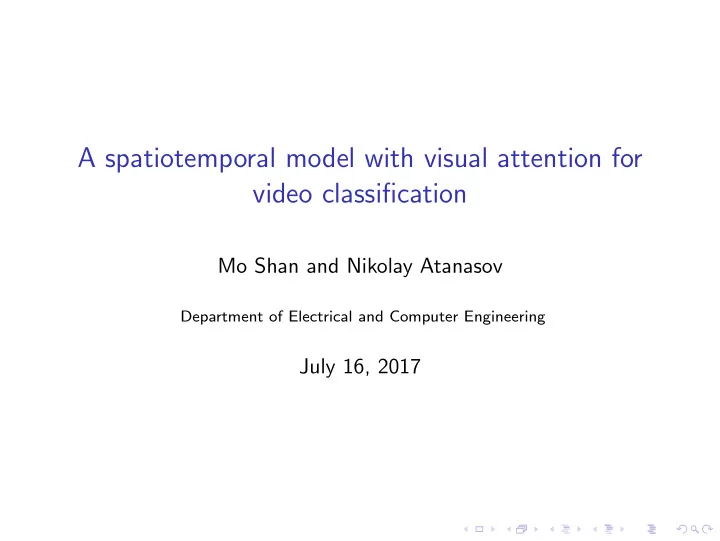

A spatiotemporal model with visual attention for video classification Mo Shan and Nikolay Atanasov Department of Electrical and Computer Engineering July 16, 2017
Outline Motivation Proposed model Experiment Conclusion
Motivation Video classification ◮ Semantic understanding of sequential visual input is important for robots in localization and object detection. ◮ Eg, search for a cat in a living room, instead of in a gym.
Motivation Rotation and scale ◮ Existing benchmark contains videos of daily scenes. ◮ Objects in real world could be rotated and scaled.
Motivation Visual attention ◮ Attention mechanism reduces complexity and avoids cluttering. This makes it easier to deal with rotated and scaled images.
Proposed model Architecture ◮ The proposed model concatenates CNN to RNN. ◮ The CNN stage is augmented with attention modules.
Proposed model Attention modules ◮ STN (Jaderberg, 2015) learns a global affine transformation. ◮ DCN (Dai, 2017) learns offsets locally and densely.
Experiment Dataset ◮ Moving MNIST is augmented with rotation and scaling.
Experiment Quantitative analysis ◮ Results are shown in Table 1. ◮ DCN-LSTM consistently performs the best in all cases. Table: Comparison of cross entropy loss and test accuracy for the proposed model and baseline. Moving MNIST LeNet-LSTM STN-LSTM DCN-LSTM Normal 1 . 44 , 97 . 96% 1 . 98 , 87 . 26% 1 . 27 , 99 . 62% Rotation 1 . 42 , 98 . 43% 1 . 97 , 90 . 47% 1 . 29 , 99 . 70% Scaling 1 . 52 , 96 . 28% 1 . 99 , 86 . 90% 1 . 28 , 99 . 41% Rotation+Scaling 1 . 51 , 96 . 82% 1 . 99 , 89 . 10% 1 . 25 , 99 . 46%
Experiment Qualitative analysis ◮ STN could not attend to each digit individually.
Experiment Digit gesture classification ◮ Elastic deformation simulates oscillations of hand muscles. ◮ Results are shown in Table 2. ◮ DCN could learn the deformation field explicitly. ◮ DCN-LSTM has the potential to handle articulated objects. Table: Cross entropy loss and test accuracy for deformed digits. LeNet-LSTM STN-LSTM DCN-LSTM 1 . 48 , 97 . 19% 1 . 48 , 97 . 19% 1 . 28 , 99 . 30%
Conclusion Key insights ◮ DCN-LSTM achieves high accuracy compared to baseline. ◮ Attention isuseful to deal with rotation and scale changes. ◮ STN-LSTM performs poorly due to global transformation. ◮ Future work: how to train the entire model end to end.
Recommend
More recommend